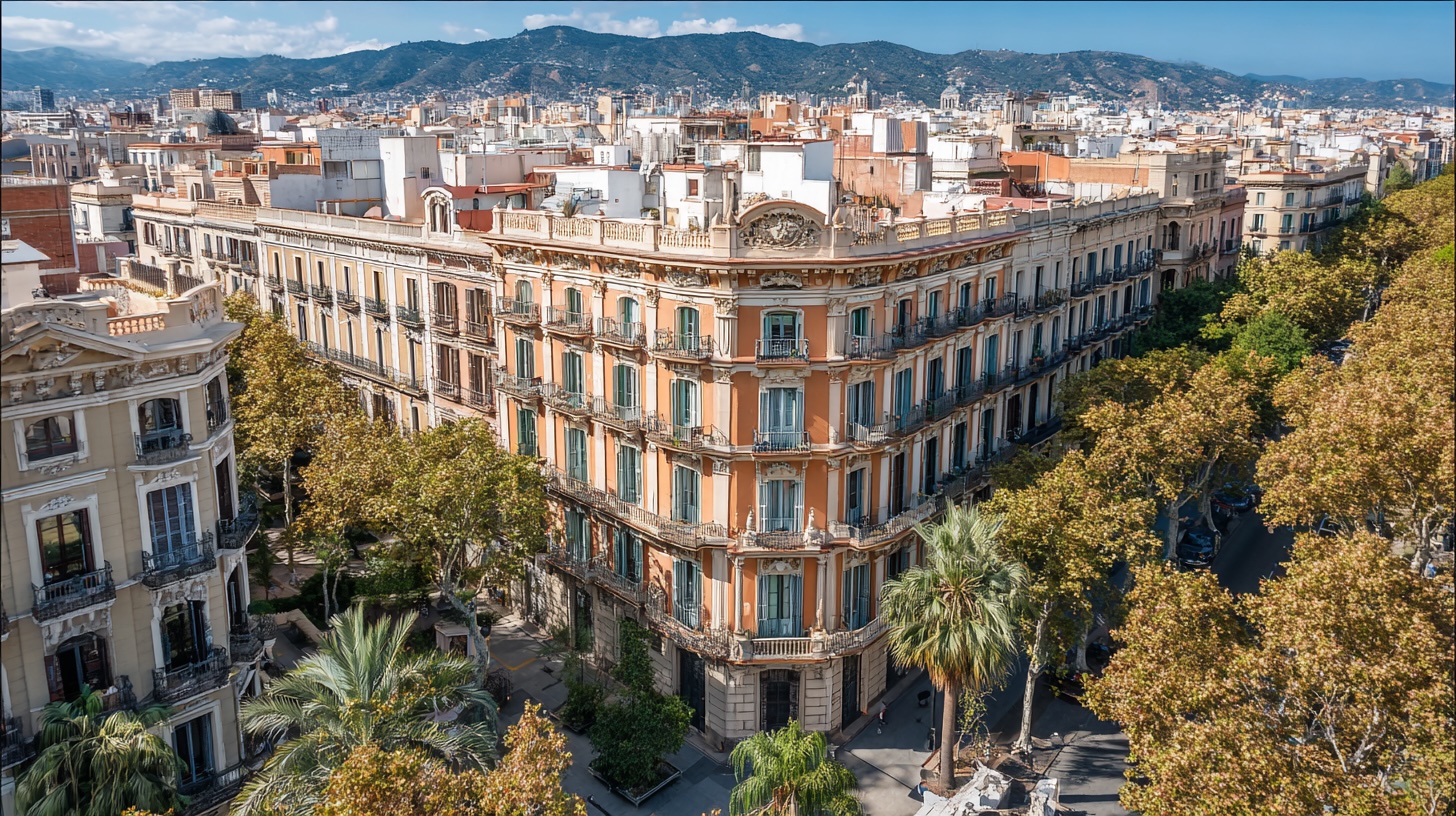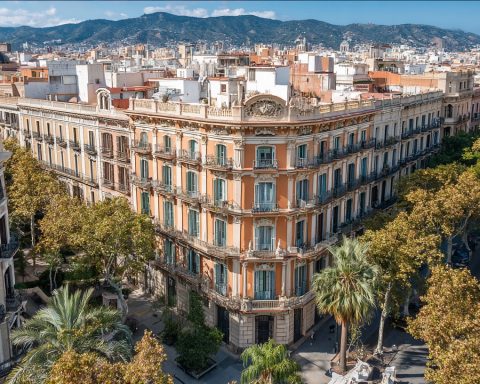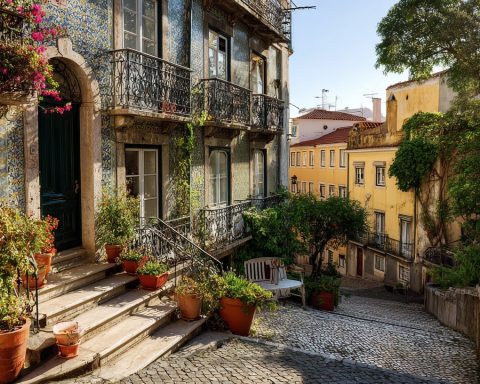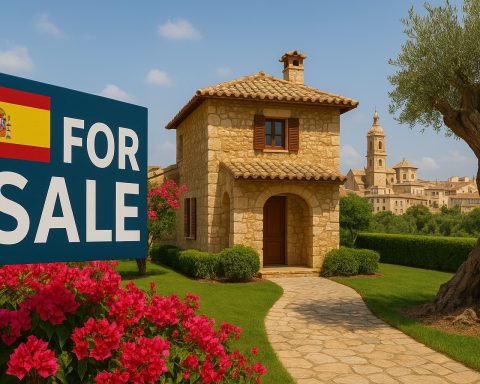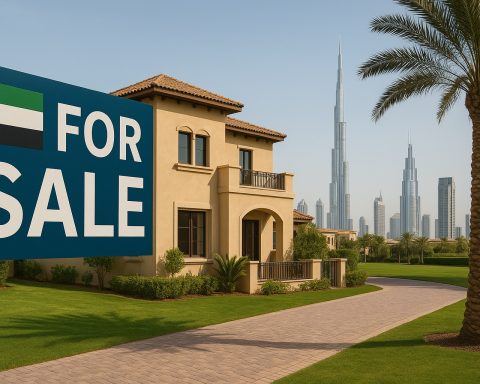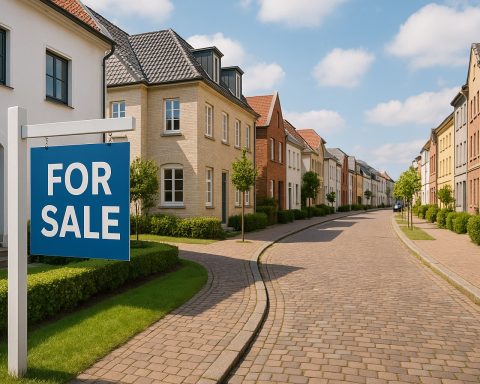Barcelona’s property market is on fire in 2025 – prices have hit record highs and apartments are vanishing from the market in mere hours euroweeklynews.com. A post-pandemic surge in demand, combined with tight supply and a rebounding economy, has turned the Catalan capital into one of Europe’s hottest real estate arenas realestateharper.com. The city’s housing stock is under pressure from soaring buyer interest and a record influx of tourists (94 million visited Spain in 2024) fueling rental demand reuters.com. In response, authorities are rolling out bold housing policies to tame speculation and keep homes affordable for locals euroweeklynews.com. Below, we dive into Barcelona’s 2025 real estate trends, from skyrocketing prices and neighborhood hotspots to commercial sector shifts, government interventions, and expert forecasts for the next few years.
2025 Market Overview
Barcelona’s real estate market in 2025 is characterized by brisk sales, escalating prices, and intense demand across both residential and commercial sectors. Property values have now surpassed their pre-2008 peak, reaching all-time highs spain-costas.com. At the same time, the city faces a housing crunch, with rents soaring and fierce competition for apartments. The economic backdrop is largely positive – Spain’s GDP is set to grow ~2.6% in 2025 amid strong job creation and tourism recovery cbre.es cbre.es – which further props up real estate activity. However, chronic undersupply of new housing and policy uncertainties pose ongoing challenges.
2025 Market at a Glance:
- Record Pricing: The average home price in Barcelona hit about €4,900 per m² in May 2025, up 10–12% year-on-year idealista.com spain-costas.com. This is over double Spain’s national average (~€2,350/m²) spain-costas.com, underlining the city’s extreme demand. In fact, prices have risen every month since early 2023, reaching historic highs spain-costas.com unseen since tracking began.
- Soaring Rents: Rents are at all-time highs. Barcelona remains the most expensive rental market in Spain at €23.2 per m² (as of late 2024), after a 14.4% annual jump idealista.com. By comparison, the next priciest cities (San Sebastián, Palma) trail far behind at ~€17–18.5/m² idealista.com. Long-term rentals are snapped up by students, professionals and “digital nomads” within hours of listing euroweeklynews.com realestateharper.com, keeping gross rental yields for investors attractive (averaging ~7.5% citywide) globalpropertyguide.com.
- High Demand, Low Supply: Buyer demand is bolstered by an improving economy, population growth via immigration, and returning foreign buyers realestateharper.com spanishpropertyinsight.com. Home sales volume is robust – 2024 saw ~11.7% growth in transactions and 2025 is on track to approach 780,000 sales nationally, levels near the 2007 boom spanishpropertyinsight.com en.ggrealestate.barcelona. Yet new housing construction lags far behind demand; building permits are only around ~100k units/year in Spain vs. 250k+ needed idealista.com. This structural shortage (limited land, costly construction, lengthy permitting) continues to strain affordability and fuel competition spanishpropertyinsight.com idealista.com.
- Policy Shifts: 2025 is witnessing unprecedented housing policy intervention. The Spanish government proposed 12 measures to curb speculation – including taxing empty homes, imposing a hefty tax on foreign non-resident buyers, and stricter rules for tourist rentals euroweeklynews.com euroweeklynews.com. Locally, Barcelona’s city council even floated a ban on home purchases by foreign investors who won’t reside in them 20minutos.es 20minutos.es, and maintained a requirement that 30% of new developments be affordable housing 20minutos.es. These efforts aim to cool the market and boost supply, though their long-term effects remain to be seen.
- European Context: Despite its sharp price growth, Barcelona’s absolute prices (~€5k/m²) are still moderate compared to premier European capitals like Paris or London (which often exceed €10k/m²). However, Barcelona’s 2024–25 price surge (~10% YoY) far outpaces many European cities that saw stagnation or declines amid higher interest rates en.ggrealestate.barcelona. For instance, while UK and German housing markets cooled in 2023, Barcelona’s continued rise – fueled by cash-rich foreign buyers and persistent local demand – stands in contrast. Rental growth in Barcelona also ranks among the highest in Europe for 2024 idealista.com, on par with other hot cities such as Amsterdam or Athens. In short, Barcelona has emerged from the pandemic with renewed dynamism, outstripping many peers in both price gains and investor appeal.
Residential Real Estate Trends (2025)
Strong Buyer Demand in Prime Areas
Location is still king in Barcelona. Centrally located neighborhoods – Eixample, Gràcia, El Born (Ciutat Vella), and upscale Sarrià-Sant Gervasi – continue to attract strong buyer interest in 2025 realestateharper.com. Proximity to employment hubs, good schools, parks, dining and transit boosts these districts’ appeal. Apartments with historic charm or modern renovations, plus amenities like balconies and abundant natural light, command a premium. Well-located properties often receive multiple offers, and bidding wars are not uncommon in these sought-after barrios.
International buyers have returned in force, adding to demand. After a pandemic lull, 2025 sees renewed buying from European and U.S. investors seeking second homes, relocation, or rental properties in Barcelona’s sunny climate realestateharper.com. Buyers from France, Germany, the UK, and beyond are drawn to the city’s lifestyle and relative bargain prices versus their home markets. Savvy sellers are marketing listings in multiple languages and emphasizing Barcelona’s Mediterranean quality of life (beaches, culture, healthcare) to tap into this global audience realestateharper.com.
Cooling at the Top? Moderation Signs
After several years of rapid appreciation, price growth in prime segments has begun to stabilize somewhat. While values are still rising citywide, sellers face a more price-sensitive market in 2025. Analysts note that prices in many high-end districts have “cooled slightly” and become more balanced, giving buyers some room to negotiate realestateharper.com. The ultra-luxury market (e.g. €2M+ penthouses) is more subdued, as domestic demand at those price points is limited and some foreign buyers face new taxes (see policy section). Sellers in premium areas are focusing on home presentation and strategic timing to achieve top dollar in this more normalized environment realestateharper.com. Still, no price corrections are evident – rather a gentle leveling after the steep climb.
Crucially, all of Barcelona’s districts are still seeing annual price increases, even the priciest ones. Not a single barrio is in decline – underscoring that any cooling is relative. For example, Sarrià-Sant Gervasi (the most expensive district) rose ~+9.6% YoY idealista.com, slightly less frenzied than mid-tier areas which jumped by double-digits. Overall, the residential market remains healthy and firmly favors sellers, just with a bit more cautious optimism as the rate of growth moderates from red-hot to sustainably warm.
Shifting Buyer Priorities: Sustainability and Space
Post-pandemic preferences are shaping purchases. Larger, flexible living spaces and home offices are in higher demand as remote/hybrid work remains common. Many buyers seek extra rooms or balconies/terraces for a better live-work balance. Additionally, sustainability has become a key selling point. Energy-efficient homes – equipped with solar panels, smart thermostats, double glazing, and good energy ratings – are commanding premium prices realestateharper.com. Eco-conscious buyers appreciate lower utility costs and a reduced carbon footprint, and a strong energy certificate can even sway purchase decisions realestateharper.com. Developers and renovators are responding by incorporating green features, knowing **sustainability is “no longer optional – it’s expected” in 2025 realestateharper.com. Government incentives for energy-efficient upgrades (and upcoming EU building standards) are likely to reinforce this trend moving forward.
Meanwhile, digital technology is transforming the homebuying experience. In 2025, most buyers expect to see high-quality photos, 3D virtual tours, and even AI-driven price valuations before visiting a property realestateharper.com. Real estate agents are leveraging virtual reality and big data tools to attract tech-savvy clients. Online listings with virtual walkthroughs and drone shots generate more interest, and agents without a strong digital marketing presence risk missing out realestateharper.com. In short, the residential sector is modernizing: eco-friendly, tech-enabled homes in great locations are the recipe for top value in Barcelona’s market today.
Rental Market Heat and Yields
Barcelona’s rental market remains extremely tight in 2025. Long-term rentals are in high demand from locals and foreigners alike, fueled by students, young professionals, expats, and “digital nomads” drawn to the city realestateharper.com. This demand, coupled with a limited supply of rental units (partly due to regulations curbing short-term rentals), has driven rents to record levels. As noted, the average asking rent is now €23+/m² – meaning a typical 80 m² flat rents for around €1,850 per month. Many neighborhoods saw 10–15% rent hikes year-on-year idealista.com, outpacing even the sharp rise in purchase prices. According to market data, Barcelona’s rents have been rising faster than sale prices since 2019 in almost every region spanishpropertyinsight.com, intensifying pressure on tenants.
For property owners and investors, however, the rental boom translates into robust yields. Gross rental yields in Barcelona average around 7.5% annually, which is high by Western European standards globalpropertyguide.com. Yields vary significantly by neighborhood and property type:
- In exclusive districts like Sarrià-Sant Gervasi, yields are relatively lower (on the order of 4–5% for upscale apartments) due to high capital values globalpropertyguide.com. For example, a 2-bedroom in Sarrià (~€650k price) renting for ~€2,200 yields only ~4% globalpropertyguide.com.
- In more affordable outer districts, yields are much higher. Sant Martí (which includes tech hub [email protected]) shows some of the strongest returns – e.g. a modest 2-bed purchased for ~€300k can rent for ~€2,300, yielding over 9% gross globalpropertyguide.com. Horta-Guinardó and Nou Barris similarly offer 8–9%+ yields on certain units globalpropertyguide.com globalpropertyguide.com, reflecting lower entry prices combined with steady rent demand.
- Small apartments tend to yield more than large ones. A tiny Ciutat Vella studio (old town pied-à-terre) might cost ~€188k and rent for ~€1,300, an 8.3% yield globalpropertyguide.com. Meanwhile a luxe 4-bedroom in the same area might yield half that percentage. Many investors thus focus on smaller flats in central areas or multi-unit properties to maximize rental ROI.
Importantly, all segments of the rental market are tight – even traditionally cheaper areas see competition. By one estimate, each rental listing in Barcelona receives over 120 inquiries on average euroweeklynews.com. Vacancy rates are near zero for well-priced units. This landlord’s market is tempered somewhat by new regulations (for instance, rent increase caps – see policy section), but overall rental profitability remains attractive. Landlords who offer quality units (modern appliances, good internet, etc.) and fair terms can secure reliable tenants quickly realestateharper.com and enjoy excellent long-term returns in Barcelona’s rental sector.
Commercial Real Estate Trends (2025)
Beyond housing, Barcelona’s commercial real estate sector in 2025 is experiencing its own shifts. Offices, retail, hotels, and logistics properties are all influenced by the post-pandemic economic recovery, new work habits, and the city’s booming tourism. Here are key trends by segment:
Office Market: Flight to Quality and [email protected] Dynamism
Barcelona’s office market entered 2025 on a cautious note but is showing signs of recovery. Office space demand (take-up) in Q1 2025 was about 68,000 m², which is +37% versus late 2024 but still ~36% lower than the exceptionally strong Q1 of the previous year eleconomista.es eleconomista.es. This dip in annual comparison is partly due to some large lease deals in 2024 that skewed numbers, and also a reflection of companies re-evaluating space needs in the hybrid-work era. Nonetheless, leasing activity is picking up, especially for high-quality offices.
Tenants are seeking quality over quantity. Notably, **61% of space leased in early 2025 was Grade A (modern, high-spec offices) eleconomista.es. Corporations are prioritizing energy-efficient buildings with good ventilation, natural light, and employee amenities, in line with ESG standards. Older or sub-par offices are being left behind, while prime new buildings in attractive locations are commanding premium rents. This flight to quality has pushed prime office rents to record highs – now about €30 per m²/month (approximately €360/m²/year) in Barcelona’s city center eleconomista.es. That €30/m² figure is an all-time high for the city, on par with top-tier European office hubs eleconomista.es. Landlords of modern offices report strong interest, whereas outdated offices may require upgrades or rent discounts to compete.
The geography of office demand is split mainly between the traditional city center and the booming [email protected] district. [email protected], Barcelona’s innovation and tech district in Sant Martí, accounted for 41% of all office space contracted in Q1 2025 eleconomista.es – by far the largest share. This area, a former industrial zone turned tech hub, continues to attract startups, IT firms, and even public sector offices. A notable recent deal was the Barcelona City Council itself acquiring an office building in [email protected] (Sancho de Ávila 125) of ~8,200 m² eleconomista.es eleconomista.es, underlining the district’s importance. Additionally, fast-growing tech companies like Factorial have taken large blocks (~7,900 m²) in [email protected] to expand eleconomista.es. However, even as [email protected] thrives, many companies still prefer central business district locations (Eixample, etc.) to help lure workers back to the office. In fact, about 36% of Q1 leases were in the city center, as firms aim to reduce commute times for employees eleconomista.es. This trend shows a dual preference: [email protected] for cutting-edge space and value, downtown for prestige and convenience.
On the supply side, new office completions have added fresh space but also helped reduce overall vacancy. About 82,000 m² of new offices were delivered in early 2025 (including the landmark “Edificio Estel” redevelopment) eleconomista.es. Much of this new supply was pre-leased or quickly absorbed. The influx actually lowered the office vacancy rate to 9.7% (from 10.3%) by Q1 2025 eleconomista.es – a healthy level indicating a balanced market. Vacancy is tightest in prime buildings and [email protected], whereas some older stock elsewhere remains empty. Office investment has been slow to start the year (only €37 million transacted in Q1, –58% YoY) eleconomista.es, as investors wait for clearer economic signals. But market experts expect activity to pick up later in 2025, especially for core assets, as interest rates stabilize eleconomista.es. Prime office yields in Barcelona are around 4.9% currently inmocolonial.com inmocolonial.com, slightly above Madrid’s (4.8%) – indicating international investors still see Barcelona offices as offering good relative value in Europe.
Overall, Barcelona’s office outlook is cautiously optimistic. Demand is recovering with the economy, availability is inching down, and prime rents are holding at record levels eleconomista.es. The consensus is that as long as economic growth continues, 2025 will see solid office leasing. The [email protected] district in particular is expected to drive activity – though ironically, construction in [email protected] has slowed (some projects paused), meaning future supply there is limited eleconomista.es. That could further tighten vacancies and support rent growth, especially in [email protected] and prime city-center submarkets going forward.
Retail and Hospitality: Tourism-Fueled Rebound
Barcelona’s retail property sector is buoyant again thanks to the return of massive tourist flows and revived local spending. Spain saw a record 94 million foreign tourists in 2024, and even more are anticipated in 2025 reuters.com. Barcelona, as a top destination, directly benefits from this influx. Tourist foot traffic in central shopping areas (like Portal de l’Àngel, Passeig de Gràcia, La Rambla) is back to or above pre-pandemic levels. This has driven retail rents upward for prime high-street locales and shopping centers oriented to visitors. Investors are also regaining interest in retail assets – retail was the 3rd most dynamic sector for real estate investment in Spain recently, targeting ~20% of total investment iberian.property. Market analysts forecast retail sales to grow ~3.5% in 2025 on rising consumption and tourism, which bodes well for retailers’ turnover rents cbre.es.
However, the retail landscape is evolving. The pandemic-induced e-commerce boom has leveled off in 2025 cbre.es, and shoppers are returning to stores seeking experiences. Thus, the focus is on experiential retail – landlords are courting tenants that offer entertainment, unique dining, or immersive shopping that online can’t match cbre.es. Barcelona’s malls and shopping streets are seeing more concept stores, international brand flagships, and refreshed food/beverage offerings. Retail vacancy in prime zones is very low, though secondary areas still work through some vacancies left by COVID closures. Overall, retail rents are stable or rising modestly in the best locations, and yields for prime retail have compressed slightly as investor confidence returns.
The hospitality sector is booming on the back of record tourism. Hotel occupancy and room rates have surged. International arrivals to Catalonia in Q1 2025 hit 3.5 million (a quarterly record, +6.4% YoY) catalannews.com, and hotel metrics reflect this: average daily rates (ADR) and revenue per available room (RevPAR) are up significantly from 2024 cbre.es. Barcelona’s hotels are enjoying near-peak occupancy in high season, and a 3.4% growth in total travelers is expected in 2025 cbre.es. Investors remain keen on hospitality assets; there is growing interest in luxury hotels (as affluent travel returns strongly) and in alternative accommodations like serviced apartments and hostels. One notable trend is the rise of “branded residences” and apart-hotels – blending hotel-style amenities with private apartments – which are being developed to cater to long-stay tourists and remote workers cbre.es.
A major factor in hospitality is the regulatory push against short-term rentals (e.g. Airbnb). Barcelona’s city government has long restricted new tourist apartment licenses, and now plans to phase out all private short-term rentals by 2028 reuters.com. This policy is intended to protect local housing affordability by steering visitors to hotels instead. In the short term, it has contributed to limited supply in the rental market (pushing renters to hotels or licensed apart-hotels) and bolstered hotel demand. Hoteliers generally welcome the crackdown on unlicensed flats. The Bank of Spain even warned that tourism-driven housing demand was hurting local housing access idealista.com, so stricter enforcement is expected. For investors, this means traditional hospitality (hotels, hostels) should continue to thrive, while any remaining short-let apartment investors may exit or convert to longer rentals.
Industrial & Logistics: Tight Land, Strong Demand
In the industrial and logistics arena, Barcelona remains constrained by geography but in high demand for distribution centers. The logistics market saw about 150,000 m² of warehouse take-up in Q1 2025 in the Barcelona area en.savills.es. While not record-setting (Valencia surprisingly exceeded Barcelona in Q1 volume), it’s in line with the five-year average – indicating stable expansion cbre.es. Third-party logistics operators, e-commerce distributors, and retail chains are actively seeking warehouse space around Barcelona’s metro and port. The challenge is the scarcity of available land for large modern warehouses within a close radius of the city. High demand combined with very limited new supply keeps vacancy near historic lows in prime logistics parks.
This imbalance is pushing logistics rents upward. Prime logistics rents in Barcelona are climbing and expected to continue rising in 2025 cbre.es, given that any new high-quality facility finds takers quickly. For example, the Zona Franca near the port and newer logistics hubs along the AP-7 corridor are seeing rent growth due to bidding from multiple tenants. Logistics investment picked up recently as well – some big portfolio deals returned to the market in late 2024 cbre.es. As a result, prime logistics yields have tightened (compressed) further, now around ~4.5% or even lower assets.cushmanwakefield.com, reflecting strong investor appetite for industrial assets. In sum, Barcelona’s industrial real estate is a landlord’s market: robust demand from Spain’s thriving trade and e-commerce, against a backdrop of chronically tight supply. Barring a significant increase in developable land (which is unlikely without major zoning changes outside the city), this sector should remain dynamic and undersupplied, keeping rents and values on an upward trajectory.
Property Prices & Neighborhood Trends
Barcelona is a city of distinct neighborhoods, and real estate values vary dramatically across its districts. Generally, a north-south wealth divide persists: uptown and central districts command the highest prices, while outlying areas in the south and periphery are more affordable. All areas are seeing growth, but some previously undervalued neighborhoods are now rising fastest. Let’s break down the landscape:
As shown above, Sarrià-Sant Gervasi remains the city’s most expensive district at about €6,350/m² idealista.com. This leafy uptown area (home to many foreign schools and luxury homes) saw prices rise +9.6% YoY idealista.com, maintaining its elite status. Just behind is the central Eixample (at ~€6,150/m², +11.9% YoY) idealista.com – the iconic grid of Modernista apartments is perennially popular among both local professionals and international buyers. Other high-price districts include Les Corts (€5,923, +9.3%) and Gràcia (€5,207, +9%) idealista.com, both of which combine charm and convenience. It’s worth noting that even Ciutat Vella (Old Town), historically cheaper due to older stock, now averages €4,716/m² idealista.com. In fact, Ciutat Vella no longer ranks in the top 5 priciest (it’s edged out by Sant Martí’s surge) but still grew +6.1% YoY idealista.com.
On the other end, Nou Barris is the most affordable district, averaging €2,599/m² idealista.com. Nou Barris, in the far north, has many post-war apartment blocks and historically lower-income residents. Yet even here, values jumped +8.6% in the past year idealista.com, reflecting that no part of Barcelona is being left behind in this boom. Other relatively affordable districts are Sant Andreu (€3,591, +8.5%) and Horta-Guinardó (€3,685, +14.3%) idealista.com idealista.com – both in the northern periphery with a mix of older flats and some newer developments. Sants-Montjuïc (southwest, €4,292) is a mid-priced area but notably logged the highest annual growth: +17.4% – the steepest of all districts idealista.com. This huge jump in Sants-Montjuïc values (which include neighborhoods like Poble-sec, Sant Antoni, and around Plaça Espanya) suggests it’s an area to watch – possibly benefitting from spillover demand as buyers priced out of Eixample or Ciutat Vella seek nearby alternatives spain-costas.com spain-costas.com.
Key takeaways from the neighborhood data: Every corner of Barcelona is getting more expensive – “even the most affordable district, Nou Barris, rose +11%” year-on-year spain-costas.com – but the fastest growth is occurring in up-and-coming areas. Sants-Montjuïc’s 17% leap leads the pack spain-costas.com spain-costas.com, likely driven by its improving amenities and central location (this district borders the city center and has seen regeneration around old industrial sites). Sant Martí (which spans from the [email protected] tech zone to beachfront) also grew a hefty +14.7% idealista.com, as it attracts both residential and commercial investment. By contrast, wealthy Sarrià’s +9.6% and posh Pedralbes (part of Les Corts) +7.2% increase spain-costas.com, while significant, are relatively modest – suggesting these were already at a high base.
These trends highlight an important dynamic: price convergence. The gap between the top and bottom districts has narrowed slightly as cheaper areas appreciate faster. For instance, a few years ago Nou Barris was barely €2,000/m²; now it’s ~€2,600 and rising. Meanwhile, Sarrià was around €5,500 and is now €6,300 – still higher in absolute terms, but not accelerating as fast. Industry experts note that all districts saw at least +6% YoY gains idealista.com, indicating a broad-based upswing rather than a narrow luxury boom. This broad growth is a hallmark of a market with fundamentally more buyers than sellers across the spectrum.
For homebuyers and investors, understanding these neighborhood patterns is crucial. Prime central zones (Eixample, Gràcia, Sarrià) offer stability and enduring desirability, but with lower yields and price growth that may be plateauing. Peripheral and revitalizing districts (Sants-Montjuïc, Sant Martí, Horta) currently offer more upside potential – they’re still comparatively affordable and posting double-digit appreciation, plus higher rental returns. Many such areas are benefitting from new infrastructure, urban renewal projects, or shifts in lifestyle preference (e.g. families seeking bigger spaces slightly further out). In the next section, we highlight some of the key investment opportunities and high-growth areas emerging from these trends.
Investment Opportunities & High-Growth Areas
Given Barcelona’s overall price surge, investors might wonder: Where are the best opportunities now? Here we outline areas and strategies showing high growth potential:
- [email protected] District (Sant Martí): The [email protected] innovation district is a magnet for both commercial and residential investment. Its transformation from old factories into a tech hub has boosted local housing demand. Sant Martí district not only saw prices jump ~15% in the past year idealista.com, but also offers some of the city’s highest rental yields (often 7–9%) globalpropertyguide.com. Neighborhoods like Poblenou and Diagonal Mar combine modern apartment developments with proximity to tech offices and the beach – making them appealing to young professionals and expats. As [email protected] continues to attract companies, housing here should remain a growth story. Investors are targeting renovated lofts and new condos in this area, expecting both capital appreciation and solid rental income.
- Sants-Montjuïc & Sant Antoni: The stellar +17% price growth in Sants-Montjuïc idealista.com flags it as an emerging hotspot. Sub-neighborhoods such as Poble-sec (with its trendy nightlife and new arts campus), Sant Antoni (famous for its market and café scene), and areas around Plaça d’Espanya are all gentrifying rapidly. These locales are just outside the city center, so they offer slightly more space for the money while still being very central. Developers have been converting older buildings into modern flats here, and new projects near Montjuïc (the Olympic area) are in the pipeline. With the district’s relatively affordable prices (~€4.3k/m²) and central location, there’s room for further growth. Investors looking for the “next Eixample” are increasingly betting on Sant Antoni and Poble-sec, anticipating continued double-digit appreciation as these areas fully revitalize.
- Nou Barris & Peripheral Districts: Barcelona’s cheapest districts (Nou Barris, Horta-Guinardó, Sant Andreu) are drawing interest from value-focused investors. These areas, historically working-class, are benefitting from gradual improvement in transport links and amenities. For example, the extension of metro lines and new parks have improved parts of Nou Barris and Horta. While capital appreciation here was strong (~8–14% last year) idealista.com, prices are still 40–50% lower than the city average, suggesting a lot of catch-up potential if Barcelona’s growth remains inclusive. Rental demand is robust in these districts from lower-income families and new immigrants, resulting in excellent yields (often 7–8%) globalpropertyguide.com globalpropertyguide.com. Savvy investors are buying multiple inexpensive flats in these neighborhoods to diversify risk. There is also interest in parking and storage spaces in these dense districts, as car ownership remains high and such facilities are scarce. While these peripheral zones lack the glamour of central Barcelona, they offer some of the highest returns on investment and could see outsized gains if the city’s expansion continues.
- Luxury & Prime Property (Selective Bets): At the high end, Barcelona’s luxury segment is more mature, but certain niches remain attractive. Ultra-prime properties in Pedralbes (upper Les Corts), Turó Park (Sarrià) or seafront villas in Barceloneta still see demand from global high-net-worth buyers. With foreign millionaires facing possible new taxes (e.g. the proposed 100% tax on non-resident purchases for non-EU buyers xataka.com xataka.com), some luxury investors are accelerating purchases now to lock in an asset. While yields on luxury are low (~3–4%), these assets are viewed as safe havens and status symbols. Additionally, redevelopment opportunities – such as buying elegant but outdated Eixample flats and refurbishing them to luxury standards – can be profitable. The spread between second-hand and new luxury unit prices remains significant, so flippers and developers who can add value through renovation stand to gain. In summary, the broad luxury market may be leveling off, but specific high-quality assets in unbeatable locations will continue to appreciate, especially as Barcelona remains a relatively good value for luxury by international comparison.
- Buy-to-Rent and New Developments: Institutional investors are increasingly eyeing build-to-rent projects in Barcelona. Given the chronic housing shortage, developing new rental apartments can be lucrative. The city’s first large-scale private rental projects (often backed by foreign funds) are underway, focusing on areas like L’Hospitalet (metro area) or redevelopment zones like La Sagrera. La Sagrera, in Sant Andreu, is the site of a huge upcoming AVE high-speed rail station (completing by ~2026–27) and a planned 2,000-unit affordable housing development es.wikipedia.org. This will likely uplift its surroundings significantly. Investors with a 5–10 year horizon see these infrastructure-driven opportunities as future goldmines – much like how values around London’s Crossrail stations jumped. Though red tape in Spain is notorious (and Barcelona’s 30% affordable housing mandate adds cost), those who can navigate it may benefit from pent-up demand for new housing stock. Additionally, Spain’s government is encouraging public-private partnerships to build more housing, which could open new avenues for investment in the coming years.
In all, Barcelona’s investment landscape in 2025 favors both ends of the spectrum: value-investors targeting rising working-class districts for yield and growth, and strategic investors cherry-picking unique prime assets or development plays. Mid-market, already-priced-in areas are a bit less exciting in comparison. As always, due diligence on location and regulatory climate is key – but given the city’s strong fundamentals (international appeal, limited land, growing population), well-chosen Barcelona real estate is expected to remain a solid bet.
Policy, Zoning, and Economic Influences
Government policy and broader economic forces are now profoundly shaping Barcelona’s real estate. 2025 marks a wave of new housing regulations and zoning changes aimed at cooling the market and addressing the affordability crisis. Meanwhile, macro trends like tourism, immigration, and interest rates also exert huge influence. Here we summarize the key factors:
Housing Policy Reforms in 2025
Spain’s national government has made housing a top political priority, rolling out an aggressive package of measures this year. In May 2025, the Housing Minister Isabel Rodríguez unveiled 12 proposals designed to rein in speculation and increase rental supply euroweeklynews.com. Notable measures include:
- Taxing Empty Homes: Owners of vacant properties would face a special “idle home” tax via their personal income tax, roughly 1.1–2% of the home’s value per year euroweeklynews.com. The goal is to prod investors into putting empty flats on the rental market. Local councils are also encouraged to levy surcharges on vacant units via property tax (IBI) euroweeklynews.com. This comes as studies revealed Spain has 4 million empty homes, even as rental demand hits record highs euroweeklynews.com. In Barcelona, an estimated thousands of investor-owned flats sit unused, a situation now in the political crosshairs.
- Curbing Foreign Buyers: A headline-grabbing proposal is to limit home purchases by non-resident foreigners, especially from outside the EU. Spain’s Prime Minister suggested a 100% tax on buys by non-EU non-residents (effectively doubling the cost) xataka.com xataka.com. Barcelona’s city council wants to go even further – seeking legal ways to outright ban sales to foreign investors and funds unless the buyer will live in the home 20minutos.es 20minutos.es. This municipal motion (led by the ERC party) passed in January 2025 for study, reflecting public sentiment that foreign capital has priced out locals. While critics argue such bans may deter investment and be legally tricky, the fact they’re being considered at all shows how acute Barcelona’s housing angst has become.
- Rent Controls and Tenant Protections: Spain’s new Housing Law 2023 (implemented into 2025) declared Barcelona a “stressed” rental market, capping rent increases for existing contracts (e.g. 2% in 2023, 3% in 2024) and allowing regions to potentially freeze or lower rents on renewals for large landlords. Catalonia briefly had its own rent cap law in 2020 (struck down later), but the national law now imposes similar controls in high-demand areas. Additionally, large landlords (defined as owning 10+ units) face stricter rules such as offering reduced rents to vulnerable tenants. These measures aim to temper rent inflation, though April 2025 data still showed +10% YoY rent growth nationally idealista.com, indicating enforcement will be key.
- Inclusionary Zoning (30% Rule): Barcelona’s requirement that 30% of new housing developments be dedicated to affordable (protected) housing remains in effect 20minutos.es. This rule, introduced in 2018, was reaffirmed in 2025 when attempts to revoke it were voted down 20minutos.es. While it’s laudable for creating affordable units, developers complain it makes projects financially unfeasible (essentially a 30% profit cut). Indeed, new construction in Barcelona city has been sluggish, partly attributed to this rule and bureaucratic delays. The city is now exploring incentives to offset the burden (e.g. faster permits or subsidies if 30% rule is met). It’s a delicate balance: encouraging development while mandating affordability. So far, the mandate stays, signaling the city’s commitment to mixed-income growth even if it slows total supply.
- Golden Visa and Investment Funds: Spain is also reassessing its “Golden Visa” program, which granted residency to those who invest €500k+ in property. There’s political momentum to end or restrict Golden Visas for real estate, as they’re seen to inflate prices with limited benefit (a bill to eliminate them was in progress in early 2023 livingsitges.com). Additionally, institutional landlords (REITs) are under pressure – the new measures would remove REIT tax breaks unless they contribute to affordable housing, subjecting them to normal 25% corporate tax euroweeklynews.com. This is effectively a crackdown on big landlords’ profits, pushing them to either sell units or lower rents. Spain’s message is clear: housing is a social good, not just an investment asset, and those “hoarding” homes may pay a price euroweeklynews.com euroweeklynews.com.
It’s important to note many of these national proposals, as of mid-2025, are pending approval and not yet law. If fully enacted by June (as intended) euroweeklynews.com, they would mark a major intervention in the housing market. Critics worry about unintended consequences (e.g. investors fleeing, reduction in overall rental supply), while proponents argue these steps are long overdue to protect residents. Barcelona, being at the epicenter of Spain’s housing affordability crisis, will be a testing ground for the effectiveness of these policies.
Tourism and Economic Tailwinds
Barcelona’s broader economy and tourist sector heavily influence real estate dynamics:
- Tourism Boom (and Limits): Tourism has roared back – so much that it’s straining the city’s housing. As mentioned, Spain hit a record number of visitors in 2024 (exceeding even 2019), and Barcelona is practically at carrying capacity in peak seasons reuters.com reuters.com. Short-term rental platforms proliferated in the 2010s, removing many homes from the long-term market, which officials blame for rent hikes. Hence the city’s plan to eliminate all private short-term rentals by 2028 reuters.com. Already, no new licenses are issued, and illegal vacation flats are being shut down. This policy should gradually return some housing stock to locals (or at least to legally licensed long-term rentals). Additionally, Barcelona has increased the tourist tax and limited new hotel permits in the center. For real estate, this means slower growth in tourist apartment investment, but a healthier long-term rental supply. It could also push tourist accommodation investment towards hotels and alternative lodging models (which face fewer restrictions).
- Population Growth and Demographics: Contrary to some European cities that face stagnating populations, Barcelona’s population has been rising, mainly due to immigration. Spain’s improving job market and the city’s global appeal bring both low-income workers and high-skilled expats. In fact, Spain’s population hit a record high in 2023–24 largely thanks to foreign arrivals idealista.com. Barcelona sees a dual effect: an influx of young workers and students who rent (often sharing flats), and affluent foreigners (from Northern Europe, Latin America, etc.) who buy luxury properties or rent high-end apartments. Demographers note that household formation is outpacing housing construction nationally – Spain expects ~246,000 new households per year 2024–2039, while new homes built are ~85k–100k/year idealista.com. This household gap is clearly felt in Barcelona, contributing to sustained housing demand. As long as the city continues to attract people for work, study, and lifestyle (and it shows no sign of losing its allure), housing demand will remain structurally robust.
- Interest Rates and Mortgage Market: The financing environment is another crucial factor. After a sharp rise in European Central Bank rates in 2022–2023, monetary policy is shifting to easing. The ECB made multiple rate cuts in 2024, bringing the main rate down to 3% idealista.com. Further cuts are expected in 2025 idealista.com, especially if inflation comes under control. This has immediate impact: mortgage lending is picking up as borrowing costs fall. Banks are competing again for homebuyers with improved mortgage offers (some even reintroducing 30-year fixed loans at moderate rates). As credit becomes cheaper, more buyers (especially first-timers who were on the sidelines) can enter the market, adding upward pressure on prices idealista.com idealista.com. It’s a bit paradoxical – the solution to affordability (lower rates) can stimulate demand that makes prices rise further. However, experts like at BBVA Research believe price growth will moderate despite rate cuts, because values are already high and some new supply is coming in certain regions idealista.com. In Barcelona, though, with very constrained supply, cheaper mortgages mostly equate to more purchasing power chasing the same few listings, a recipe for continued price increases. This effect is likely to play out over the next 1–2 years.
- General Economy and Political Climate: Barcelona and Spain’s economy in 2025 is fairly strong – GDP growth around 2–3%, unemployment at its lowest in over a decade (though still ~10–11% nationally). A strong labor market means more people can form households and pay rent or mortgages, a positive for real estate demand spanishpropertyinsight.com. One concern is wage growth not keeping up with housing costs, stretching affordability; the average Spanish household now spends ~30% of income on mortgage payments (right at the recommended limit) spanishpropertyinsight.com, and significantly more if renting in Barcelona. If housing eats too much income, demand could soften for higher-end units or buyers might seek smaller homes. Politically, Spain will hold general elections by late 2025. A change in government could alter housing policies – for example, a more conservative government might roll back some investor taxes or push for more construction instead of caps. This creates some uncertainty. But regardless of political party, the housing supply issue will take years to fix, so the short-to-mid term outlook of tight markets probably remains.
In summary, tourism and population growth are strong tailwinds for Barcelona real estate, while government interventions and economic shifts add both opportunities and risks. The city is trying to thread the needle by calming an overheated market without crashing it, a delicate task. From an investor’s viewpoint, staying attuned to these policy changes (like new taxes or rental rules) is crucial, as they can impact returns. But overall, the fundamental imbalance of demand outstripping supply appears likely to persist, maintaining upward pressure on prices and rents in the absence of a major economic shock.
Outlook and Forecasts (2025–2030)
Looking ahead, experts predict that Barcelona’s real estate market will remain on an upward trajectory for the next several years, albeit with a gradual slowdown in growth rates. The consensus is that the double-digit annual price jumps of the past two years will taper to more moderate gains as the market seeks equilibrium. Here are the key forecasts and factors for 2025–2030:
- Home Price Forecasts: Multiple forecasts project continued price increases in Spain and Barcelona through at least 2026. BBVA Research, for instance, expects Spanish house prices to rise +7.3% in 2025 and another +5.3% in 2026 spanishpropertyinsight.com, on top of ~+5.8% in 2024. Bankinter (another bank) is slightly more conservative, forecasting +5% (2025), +3% (2026), and +2% (2027) for Spanish property prices en.ggrealestate.barcelona. These figures basically trend toward growth aligning with inflation by 2027. For Barcelona specifically, price growth may outperform the national average given its supply-demand imbalance. GG Real Estate notes that high local and foreign demand in Barcelona could lead to “a more noticeable increase in prices compared to other regions” en.ggrealestate.barcelona. In other words, if Spain does +4%, Barcelona might do +6% in a given year. By 2028–2030, many analysts see annual price growth settling in the low single digits (~2–4%/yr), assuming interest rates normalize and more housing (including suburban developments) comes on line. It’s worth noting that most of Spain is still below 2008 price peaks in real terms spanishpropertyinsight.com, so there’s room for further growth without necessarily entering bubble territory – Barcelona, however, has surpassed its previous peak, which suggests some natural cooling will occur as affordability limits are tested.
- Sales and Construction Activity: Sales volumes are expected to remain high in the near term. Economists like Gonzalo Bernardos predict home sales in Spain could reach 825,000 in 2025, levels not seen since the 2007 boom en.ggrealestate.barcelona. Barcelona will share in this brisk turnover, fueled by low interest rates and buyers rushing to act before prices climb further. On the construction front, there’s optimism for a pickup: housing starts in Spain might grow ~14% per year in 2025–26 spanishpropertyinsight.com as both public and private sectors respond to the housing shortage. The Spanish government has announced plans to facilitate tens of thousands of affordable housing units (through converting unused land, etc.), though these will materialize gradually. In Barcelona, given land constraints, new supply will likely focus on redevelopment zones (e.g. La Sagrera, portions of [email protected] still in transition, and suburbs). Still, even a building uptick won’t close the gap fully – it will just prevent conditions from getting worse. Thus, the supply crunch will persist for the foreseeable future, but any increase in new homes could modestly temper price growth by late decade.
- Rental Market Outlook: Rents are expected to keep rising in the next few years, potentially even outpacing home prices. BBVA notes that rent prices have been rising faster than sale prices since 2019 spanishpropertyinsight.com, a trend likely to continue as would-be buyers who can’t afford to purchase remain in the rental pool. With the new national rent controls, the pace might slow, but given the severe undersupply of rental units in Barcelona, most experts see upward pressure on rents for the next 3–5 years. Some forecasts suggest rent growth could be in the mid to high single digits annually (e.g. 5–8%/yr) in stressed areas, barring heavier regulation. By 2026–27, if significant rental supply is added (through build-to-rent projects or conversion of tourist flats due to the crackdown), rent inflation could finally cool to more normal levels (2–3%). But much depends on enforcement of new rules and actual delivery of new apartments. For now, landlords can expect strong demand to continue, and tenants will need to contend with a very competitive market. Rental yields should remain attractive – as long as prices are rising a bit slower than rents, yields might even expand slightly in secondary areas. In prime areas, yields will stay lower but steady (~4%).
- External Risks and X-Factors: No forecast is complete without considering risks. One potential dampener could be a global economic slowdown or financial shock (for instance, if there were a recession in major economies or a sudden spike in oil prices). That could reduce foreign buyer interest and temper local demand (through job losses), leading to flatter prices. Another factor is interest rate uncertainty – while most anticipate falling rates, if inflation resurges and central banks hike again, the property market could hit a brake as mortgages become costly. Politically, Spain’s upcoming elections introduce uncertainty: a new government might reverse some housing policies or pursue different solutions (e.g. incentivize construction more, instead of market restrictions). If, for example, a future government floods the market with public housing or encourages a building boom, that could significantly increase supply by late decade and really slow price growth or even cause a dip. However, such an outcome is speculative and would take years to impact.
- Long-Term Urban Trends: Looking towards 2030, Barcelona’s status as a vibrant, livable, international city is expected to persist, which underpins real estate values. The urban plan includes expanding public transport, creating more “superblocks” (pedestrian-friendly zones), and perhaps adding housing in former commercial zones. If work-from-home remains prevalent, some office spaces could convert to residential use, adding supply. Also, demographic trends like aging could see more seniors downsizing or moving out, freeing up some housing (though Barcelona is youthful compared to the rest of Spain). Climate change is a distant concern – being coastal, the city might invest more in resilient infrastructure, but there’s no immediate threat to property. On balance, Barcelona 2030 is likely to be more dense, with higher property values and rents than today, but with hopefully more innovative housing solutions implemented.
Expert sentiment tends to agree that a soft landing is possible: the market will keep climbing, just not as rapidly. As one economist summarized, “the upward trend will continue, though somewhat more contained”, since the supply-demand imbalance won’t be immediately corrected idealista.com. Barring a major policy shock or economic crisis, no one is predicting a crash. Instead, the baseline scenario is continued growth in the next 3–5 years, gradually easing into a stable plateau by the end of the decade as interest rates fall and housing production (hopefully) increases. For homeowners, this implies further equity gains (though less dramatic than recent years); for buyers, it means acting sooner rather than later, as waiting is unlikely to make things cheaper – only a bit less frenetic.
Conclusion
Barcelona’s real estate market in 2025 is red-hot and making headlines – record prices, intense competition for housing, and ambitious new laws targeting the sector. We’ve seen that both residential and commercial properties are in high demand, fueled by local needs and global interest in the city. Key neighborhoods like Eixample and Sarrià remain blue-chip, while emerging districts like Sant Martí, Sants-Montjuïc and others are rising fast and offering new opportunities. Investors are navigating a landscape of strong rental yields but also increasing regulation.
Looking forward, the market is expected to grow at a steadier pace, but fundamental drivers – a vibrant economy, population growth, and constrained housing supply – suggest that Barcelona will continue to be a challenging market for home-seekers and an enticing one for investors. Government interventions may moderate the extremes (e.g. deter pure speculators and boost affordable housing), yet the city’s desirability means demand will likely outstrip supply for years to come. In comparison to other major European cities, Barcelona is now firmly on the map as a real estate hotspot, offering higher yields and growth than many of its peers globalpropertyguide.com en.ggrealestate.barcelona, while still being relatively affordable in continental terms – a combination that international investors find attractive.
In summary, Barcelona’s property market in 2025 marries record-breaking current performance with a hopeful, measured future. Whether you’re a buyer, seller, or investor, staying informed on these trends – from neighborhood price shifts to new housing laws – is crucial to success. As the Catalan capital continues its post-pandemic renaissance, one thing is clear: Barcelona’s bricks and mortar are as golden as its Mediterranean sunshine, and everyone wants a piece of it.
Sources:
- Idealista News – Barcelona price and rent reports, May 2025 idealista.com idealista.com idealista.com
- Spain Costas / Idealista – Barcelona housing prices near €5,000/m² (2025) spain-costas.com spain-costas.com
- EuroWeekly News – Spain to tax empty homes & foreign buyers (May 2025) euroweeklynews.com euroweeklynews.com
- 20minutos / El Periódico – Barcelona to study banning foreign home buyers (Jan 2025) 20minutos.es 20minutos.es
- El Economista – Office market stats, Barcelona Q1 2025 eleconomista.es eleconomista.es
- BBVA Research via SPI – Housing prices forecast 2025–26 spanishpropertyinsight.com
- Global Property Guide – Barcelona rental yields by district (Q1 2025) globalpropertyguide.com globalpropertyguide.com
- Reuters – Record tourism and housing impact in Barcelona reuters.com reuters.com
- Harper Real Estate Blog – Trends shaping Barcelona real estate 2025 realestateharper.com realestateharper.com
- CBRE Spain – Real Estate Market Outlook 2025 (Spain) cbre.es cbre.es
